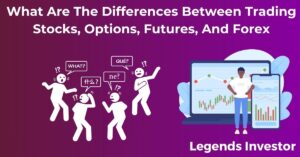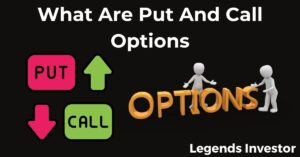Understanding Options Trading: The Foundation
Options trading can be an exciting yet complex financial strategy that allows traders to speculate on asset price movements without directly owning the asset. Before diving into options trading, it’s essential to have a solid understanding of the basics. Here’s an in-depth look into the foundation of options trading, including its types, how it works, and essential terminology.
Defining Options and Their Types (Calls vs. Puts)
Options are financial derivatives that give traders the right, but not the obligation, to buy or sell an underlying asset at a specified price within a particular time frame. The two main types of options are calls and puts:
- Call Option: A call option gives the holder the right to buy the underlying asset at the strike price before the option expires. Traders buy call options when they expect the asset’s price to rise.
- Put Option: A put option gives the holder the right to sell the underlying asset at the strike price before expiration. Traders buy put options when they expect the asset’s price to fall.
How Options Trading Works
To better understand options trading, let’s break down a basic transaction:
- Buyer and Seller: Every option contract has a buyer and a seller. The buyer pays a premium for the option, and the seller receives the premium while taking on the obligation to fulfill the contract terms.
- Strike Price: The strike price is the price at which the underlying asset can be bought or sold if the option is exercised.
- Expiration Date: Options contracts have expiration dates, meaning the trader must decide to exercise the option or let it expire.
- Premium: The premium is the price paid for the option. It’s influenced by factors such as the underlying asset’s price, volatility, and time until expiration.
Common Terminology Used in Options Trading
- In-the-money (ITM): A call option is ITM when the underlying asset’s price is above the strike price. A put option is ITM when the asset’s price is below the strike price.
- Out-of-the-money (OTM): A call option is OTM when the underlying asset’s price is below the strike price, and a put option is OTM when the price is above the strike price.
- At-the-money (ATM): An option is ATM when the underlying asset’s price equals the strike price.
Importance of Education and Knowledge
Education is paramount in options trading due to its inherent complexity. Many traders jump into options trading without fully grasping the mechanics, leading to costly mistakes. Therefore, investing time in learning the basics of options trading, including strategies, market behavior, and risk management, is essential before placing trades.
Inadequate Research and Analysis
When traders overlook fundamental and technical analysis, they put themselves at a disadvantage. Options trading is highly data-driven, and relying solely on gut feelings without proper research can lead to failure.
Ignoring Fundamental and Technical Analysis
Fundamental analysis involves evaluating an asset’s intrinsic value by looking at financial statements, earnings reports, and overall industry trends. Technical analysis focuses on chart patterns, price movements, and market sentiment to predict future price directions. Ignoring these analytical tools is a common mistake in options trading.
Over-reliance on Gut Feeling Rather Than Data
Many traders, especially beginners, may trade based on intuition rather than data. While intuition can sometimes lead to success, over-reliance on it can cause you to make uninformed decisions. Trading based on emotion rather than facts is a recipe for failure in the long run.
Failing to Keep Up with Market News and Trends
Market news and trends are crucial in options trading. Events like earnings announcements, geopolitical shifts, or changes in interest rates can impact asset prices significantly. Keeping up with these developments allows you to make informed decisions and stay ahead of the curve.
Tools and Resources for Proper Research
Successful options traders use various tools and resources to analyze the market. These include:
- Stock screeners: To filter stocks based on specific criteria.
- Technical indicators: Such as moving averages, RSI, and MACD.
- News platforms: To stay updated with the latest market news.
- Charting software: To track price movements and identify trends.
Investing in quality research tools can make all the difference in the accuracy of your trades.
Overconfidence and Emotional Trading
Overconfidence is one of the biggest pitfalls in trading. It leads traders to take unnecessary risks, often leading to significant losses. Combined with emotional trading, this can be a disastrous combination.
The Dangers of Overconfidence in Trading
When traders experience a few successful trades, they may become overconfident and assume they have mastered the market. This can lead to taking on larger risks or abandoning proven strategies. Remember, even seasoned traders experience losses, and no one is immune to market fluctuations.
How Emotions Like Greed and Fear Affect Decisions
Emotions, particularly greed and fear, often cloud judgment in trading. Greed may cause traders to hold onto positions too long, hoping for more profit, while fear can make them sell too early, missing potential gains. These emotional reactions lead to impulsive decisions that aren’t based on sound analysis.
Importance of Maintaining a Disciplined Approach
Discipline is crucial to consistent success in options trading. Sticking to a well-defined strategy, regardless of emotional impulses, allows traders to make decisions based on logic and research rather than reactions to market movements.
Tips for Avoiding Emotional Trading
- Set predefined rules for entering and exiting trades.
- Use stop-loss orders to automatically close positions when they reach a certain level.
- Take regular breaks to avoid making impulsive trades.
- Review past trades to identify emotional decisions and learn from them.
Poor Risk Management
In any form of trading, risk management is key. Options trading offers the potential for high rewards, but with high rewards comes the risk of substantial losses.
Determining an Acceptable Level of Risk
Each trader must determine their own risk tolerance, considering their financial situation and trading goals. A good rule of thumb is never to risk more than you can afford to lose on a single trade. Proper risk assessment is vital to long-term trading success.
The Importance of Setting Stop-loss Orders
Stop-loss orders are critical tools that allow traders to limit their losses. By setting a predetermined exit point, you ensure that if the market moves against you, your position is automatically closed at a manageable loss.
Avoiding the Mistake of Not Diversifying
Many traders make the mistake of putting all their eggs in one basket. Failing to diversify across different assets or sectors can lead to significant losses if a single trade doesn’t go as planned. Diversification helps spread risk and protect your portfolio.
Utilizing Risk Management Tools and Strategies
Apart from stop-loss orders, traders can also use options-specific strategies like:
- Hedging: To protect against adverse price movements.
- Spreads: To limit risk while maintaining the potential for profit.
- Position sizing: To ensure that individual trades don’t represent an outsized portion of your portfolio.
Misunderstanding Leverage and Margin
Leverage and margin trading can be powerful tools, but they can also amplify losses if not used correctly. Many novice traders misuse leverage, leading to disastrous outcomes.
Explanation of Leverage and Margin Concepts
Leverage allows traders to control a large position with a small amount of capital by borrowing funds. Margin is the amount of money required to open a leveraged position.
Dangers of Using Excessive Leverage
Excessive leverage can magnify profits, but it also increases the potential for losses. A small adverse movement in the asset’s price can wipe out your position and even result in losses greater than your initial investment.
How to Use Leverage Responsibly
To use leverage responsibly:
- Understand the risks: Never trade on margin without fully understanding how it works.
- Limit leverage: Use the lowest possible leverage to achieve your trading goals.
- Set strict risk management rules: Always have a plan in place for exiting trades if the market moves against you.
Risks and Rewards of Trading on Margin
While trading on margin offers the potential for increased profits, it also exposes traders to greater risks. For beginners, it’s essential to start with a small amount of leverage and gradually increase it as you gain experience.
Neglecting to Develop a Trading Strategy
A well-defined trading strategy is the cornerstone of success in options trading. Without one, traders are likely to make impulsive decisions, leading to inconsistent results.
Components of a Solid Trading Strategy
A comprehensive trading strategy should include:
- Entry and exit points: Clear criteria for when to enter and exit trades.
- Risk management rules: Guidelines for managing risk, including stop-loss orders and position sizing.
- Market analysis: Incorporating both fundamental and technical analysis.
Why a Well-Defined Strategy Is Crucial
Without a well-defined strategy, traders are more likely to make emotional decisions and trade reactively. A strategy helps ensure that all trading decisions are based on research and logic rather than impulse.
Common Pitfalls of Trading Without a Strategy
Traders without a strategy often:
- Overtrade, leading to high transaction costs.
- Chase losses by taking on increasingly risky positions.
- Fail to adapt to market conditions, leading to unnecessary losses.
How to Develop and Stick to a Trading Plan
To develop a solid trading plan:
- Define your trading goals: Are you looking for short-term profits or long-term growth?
- Choose a trading style: Whether it’s day trading, swing trading, or position trading, find what suits your risk tolerance and time commitment.
- Stick to the plan: Don’t deviate from your strategy based on emotions or market noise.
**Failing to Adapt to Market
Conditions**
Markets are constantly evolving, and traders who fail to adapt to changing conditions often find themselves struggling.
How Market Conditions Affect Trading
Different market conditions require different trading strategies. For example, a strategy that works in a bull market may not perform well during a bear market. Understanding how various conditions impact options prices is essential.
Importance of Flexibility and Adaptability
Successful traders remain flexible and adjust their strategies as market conditions change. Flexibility allows traders to capitalize on new opportunities while mitigating risks.
Recognizing and Responding to Changing Trends
Traders must be able to recognize trends early and adjust their positions accordingly. Whether it’s a shift in market sentiment or new economic data, being agile is key to staying profitable.
Advice for Staying Agile in Volatile Markets
- Monitor key indicators like volatility indices (VIX).
- Use trailing stops to protect profits in volatile conditions.
- Stay informed with real-time news and updates.
Ignoring the Impact of Fees and Commissions
Fees and commissions can significantly erode profits over time, especially for active traders.
Types of Fees and Commissions in Options Trading
Options traders face various costs, including:
- Commission fees: Charged per trade or per contract.
- Exercise and assignment fees: For exercising or being assigned options.
- Platform fees: Charged by brokers for using their trading platforms.
How Fees Can Erode Profits Over Time
High fees can quickly eat into profits, especially if you’re making frequent trades. Even small fees, when compounded over time, can have a significant impact on your overall returns.
Comparing Brokers Based on Fee Structures
It’s crucial to choose a broker with a transparent and competitive fee structure. Some brokers offer commission-free trading, while others charge a flat rate per trade. Compare options to find the one that fits your trading style and frequency.
Strategies to Minimize Trading Costs
- Limit the number of trades: Only trade when you have a strong conviction.
- Use a commission-free broker: Some platforms offer no commissions on options trades.
- Trade in larger quantities: Many brokers offer discounts for larger orders.
Lack of Continual Learning and Improvement
The options market is constantly evolving, and traders who fail to keep learning will fall behind.
The Necessity of Ongoing Education in Trading
No trader ever “knows it all.” The market evolves, and staying ahead requires continual learning. This can include staying updated on new strategies, regulatory changes, or shifts in the market landscape.
Learning from Past Mistakes
Mistakes are inevitable in trading, but they provide valuable lessons. Reviewing past trades—both successful and unsuccessful—helps traders refine their strategies and avoid repeating errors.
Seeking Professional Advice and Mentorship
Seeking guidance from more experienced traders can provide new insights and strategies. Many successful traders attribute their growth to mentors who helped them navigate the complexities of the market.
Resources for Continual Learning and Improvement
- Books and courses: Many platforms offer online courses tailored to options trading.
- Webinars and workshops: Attend events hosted by industry experts.
- Trading forums: Engage with other traders to exchange ideas and strategies.
In conclusion, options trading offers vast potential but comes with its unique set of challenges. By avoiding common mistakes such as emotional trading, neglecting research, and poor risk management, traders can set themselves up for long-term success. Continual education, disciplined strategies, and adaptability are key to thriving in this dynamic market.
4o



